Today we’ve got an awesome interview with my neighbor and friend, Stephen Savage. He has a great new book out called Little Tug, and Polar Bear Morning, his sequel to the award-winning Polar Bear Night with author Lauren Thompson, comes out in January. You may also know Where’s Walrus?, a beautiful, wordless picture book about a walrus who escapes from the zoo. Stephen’s work is bold and graphic and he’s generously given us some insight into his process.
The Scoop on Stephen Savage
Hometown: Born in LA, raised in Minneapolis
Now lives in: Park Slope, Brooklyn, NY
Tools of the trade: Linocut, charcoal, computer. Sometimes I combine all 3.
Illustration idol(s): Leonard Wiesgard, Crocket Johnson, Feodor Rojankovsky, Lois Lenski
Caffeine of choice: Drip coffee, Stumptown brand. Variety: “Hairbender”
Workspace: Studio in Red Hook, Brooklyn
Cat or dog? Dog: Belgian Malinois, Trinka
Favorite children’s book
…as a child: The Whales Go By, Written by Fred Phleger, illustrated by Paul Galdone
…as an adult: Harold and the Purple Crayon, by Crocket Johnson
Favorite thing to read: children’s books!
YouTube video you can’t stop watching: I still get a kick out of “The Crazy Nastyass Honey Badger”
Must-read blog: PW’s Children’s Bookshelf (is that a blog?)
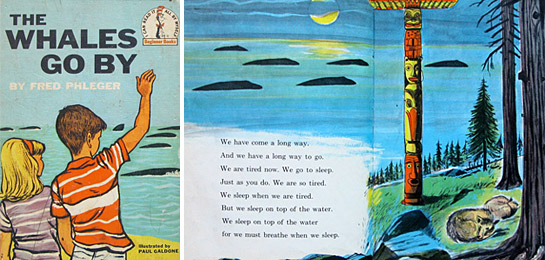
Whales Go By, By Fred Phleger, Illustrated by Paul Galdone. “I loved this book as a kid. Sooooooo much!”

Stephen printing a linocut for his newest book, Polar Bear Morning, written by Lauren Thompson. The book comes out in January 2013.
Robin: What materials do you work with and how did that come about?
Stephen: I started linocutting in grad school (MFA Illustration, School of Visual Arts). Linocut was my dominant medium for many years until I began working with Photoshop in 1999. The computer made a lot of sense for all of the editorial work I was doing at the time where the deadlines are tight and the image often prints small. For the past few years, I’ve been alternating techniques on books. Little Tug was mostly digital, but my newest book, Polar Bear Morning, is linocut. I find by changing things up you keep the art fresh.

“It was this image of Cary Grant that caught the attention of Scholastic art director and editor David Saylor and helped get me my first children’s book contract.”
Robin: What’s a typical day like for you? Do you have a routine?
Stephen: I have weekly routine: I teach all day at the School of Visual Arts on Monday. Tuesdays, Thursdays and Fridays are studio days, 9-5, and Wednesdays I watch my daughter Chloe. I usually work a few nights, too.
Robin: Do you have any friends or colleagues with whom you share your in-progress work in order to get feedback as you work?
Stephen: That’s key for me. I’ll send out an e-mail with a JPEG containing three different versions to my wife (while she’s at work), my brother (an art historian), and a few former classmates. I’ll write, “hey all, what d’ya like better: A, B or C?”
Robin: How did you find your agent (or how did your agent find you)?
Stephen: My agent is Brenda Bowen and we sorta found each other on… (where else?): FACEBOOK!
Robin: What/who are your creative influences?
Stephen: (a short list of artists) Alexander Calder, Steven Spielberg, Hugh Ferriss, David Lean, Paul Rand, Pablo Picasso, Jacob Lawrence, Hayao Miyazaki, Utagawa Hiroshige, Buster Keaton, Alex Katz, Franz Klein, Frank Lloyd Wright.
(a short list of art things) mid-century/Man Men era design, vintage luggage labels, vintage matchbooks, art deco and jazz-age design, Golden Books, Russian Constructivist posters/children’s books, logos.
Robin: Your latest book, Little Tug, has just been published by Neal Porter. Can you tell us where you got the idea for the book?
Stephen: I was walking across the Gowanus canal a few years ago, on my way to the studio, when I saw a tug boat pushing a barge. My first thought was, “that would make a great kid’s book”. Second thought was, “Uh… excuse me: ‘Little Toot’?, ‘Scuffy’?, ‘I’m Mighty’?. Tug boats have been done to death. No can do”.
Robin: Take us through your process for Little Tug. What happens from idea phase to finished artwork?
In general, which comes first the text or the images? How does it evolve?
Stephen: Each book has a different birth. In the case of Little Tug, the challenge was to learn how to write a book with words. I’d never done that before. I had authored Where’s Walrus? the year before, but that was wordless. So I grabbed a pocket notebook and put down JUST words. That was something, as an illustrator, I found terrifying.
It took me 2 or 3 weeks to come up with the text, and once it felt finished, I quickly sketched some thumbnails and paired them with the text in Quick-Time.
My editor, Neal Porter, miraculously made NO text changes. But I spent the next year developing the images and the color palette. Everything was done digitally, with some charcoal textures scanned in.
Robin: I love the color palettes for your books. They seem generally pretty tight and you’ve always got a few unexpected color combos thrown in. Do you sit down at some point during the process and formally work out a palette or is it more fluid? Where do you find inspiration for your color palettes?
Stephen: Aw, thanks. A classmate of mine, Riccardo Vecchio, taught me the value of color in storytelling. He showed me how to create a “color script”– a grid containing all of the spreads of the book laid out in sequence. This script shows you how the book is working as a whole, coloristically. I tried this for my first picture book, Polar Bear Night, and through the process, discovered I should start that book with a more muted, cool palette then slowly, turn up the volume with warmer, more saturated colors as the little bear wakes up.
Robin: How did you wind up working with Neal Porter on Little Tug?
Stephen: I e-mailed him out of the blue…
SUBJECT: let’s do a picture book sometime!
Hi Neal – Just wanted to drop you a note and say ‘hi’. I’m hoping I might get a chance to do a book for you sometime in the future. Enjoy this last week of summer. Best, Stephen
He replied:
Hey Steve – Nothing would give me greater pleasure. I’m a big fan of Polar Bear. Do you have any ideas for books you’d write yourself? Cheers, Neal
So I wrote back:
I can show you a picture book proposal (in the form of a QuickTime movie) if you like. I have it out to a few other publishers (do you mind?) Best, Steve
to that, he said:
Not at all, Steve. Send away. Best, N
then a few minutes later:
I love it. I want to do it. What next?
So in 15 minutes, I had a book contract. We never even spoke.
Robin: That’s an amazing story and I think I speak for everyone when I say we all hate you. So do you have any books that you love that have been rejected?
Stephen: When I first met David Saylor, I presented a book I wrote called Ghost Zoo. He liked the image of a ghost bear in the moonlight (which later inspired Lauren Thompson to write Polar Bear Night) but didn’t really care for the text. Admittedly, it was a little dark for kids. Recently, though, I’ve been considering re-working the idea into an animation or adult gift book.

Stephen’s ghost bear from unpublished Ghost Zoo. The image inspired Laura Thompson to write Polar Bear Night.
Robin: The typography on your covers is also always great. Do you have anything to do with that or have you been lucky to have great Art Directors?
Stephen: Aw, thanks again. I’ve done the type on my last 3 books, with lots of help. My design work with Scholastic (the Polar Bear books and Where’s Walrus?), is done in collaboration with my art director and editor, David Saylor. He’s great and has taught me a lot. We go through countless drafts, pushing and pulling type and playing with colors.
Robin: You’ve got some awesome videos to promote your books and show your process. How did these come about? Do you initiate and make these yourself or is it something you work with your publisher on?
Stephen: After I completed Where’s Walrus?, a neighbor of mine put me in contact with music video director David Franklin of Artisanal Television, here in Brooklyn. He liked the book and agreed to write and direct a promotional video and we pitched the idea to Scholastic. He’s just completed his third trailer for me, a “making-of” documentary style video for Polar Bear Morning. He does great work and the videos always grab everybody’s attention.
Here are the links:
WHERE’S WALRUS?
LITTLE TUG
POLAR BEAR MORNING
AND FINALLY
Robin: What do you wish we had asked, and what’s the answer?
Stephen: You could have asked me the quintessential 1970’s question: “What’s your sign?” The answer is: I’m an Aquarius. And true to form, I like to “march to the tune of my own drum”.
Stephen provided us with so much great material that it just won’t all fit into one post. Stay tuned next Wednesday, 12/19/12 for a BONUS WHERE’S WALRUS? POST with process sketches. Thanks Stephen!
Check out more of Stephen Savage’s work here.






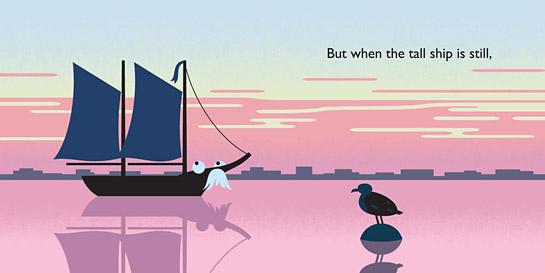
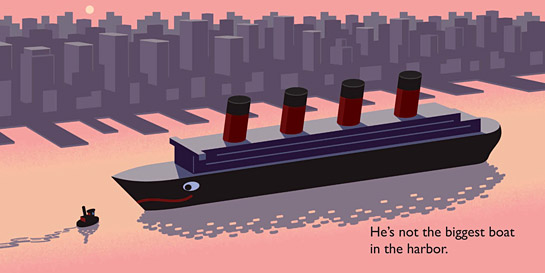
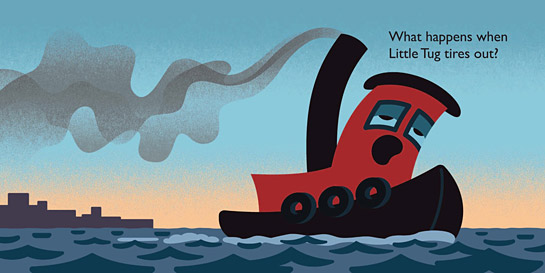

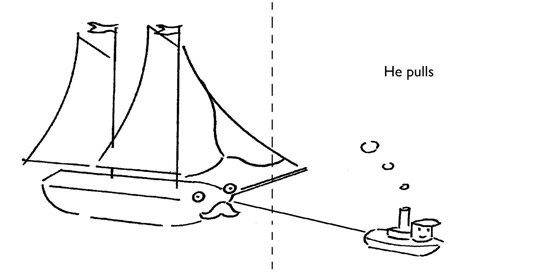


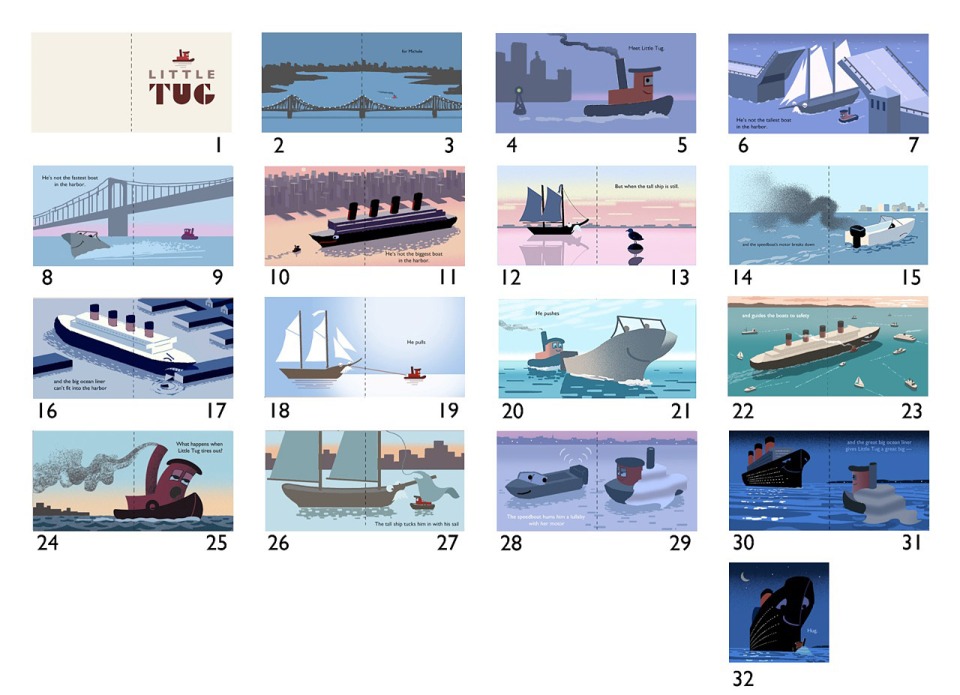
Pingback: Behind the Scenes: Where’s Walrus? «
Great interview, loved to hear about pitching a dummy with a quicktime video.
LikeLike
Pingback: Rounding up posts at the old Pen & Oink ranch |